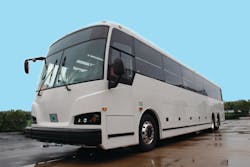Next-Generation Solutions Materialize for Public Bus Transportation
The American Public Transportation Association's (APTA) 2013 Fact Book addresses a critical requirement for the public passenger and transit bus industry, the Federal Transit Administration's establishment of "a minimum useful life that a vehicle must exceed before federal financial assistance can be used to replace the vehicle." What this translates to is a watchful eye over the quality of passenger bus fabrication. No imitations will be accepted.
Based on a sample from the annual APTA Public Transportation Vehicle Database, the Fact Book statistics show all modes of buses have an 8-year average age, a minimum useful life of 12 years and 5 percent already rehabilitated during their lifetime.
Also stated, a large percentage of passenger and transit buses exceed that age, while many "have been rehabilitated, which not only extends their useful lives and reduces their maintenance costs, but also extends the age at which they may be replaced." Why are transit operators currently pulling public buses off the road for maintenance when the buses of tomorrow can be built today?
Crompion International, a specialty solutions provider for the bus industry, has answered the call for longer vehicle life with Cromgard Specialty Stainless Steels. Well-suited to stand up to the challenging corrosive, abrasive and cold temperature environments many transit authorities operate their buses in across the country, Cromgard C12 is a low-cost, next-generation stainless steel. Providing added strength, reduced energy costs via lower weight, corrosion and abrasion resistance, durability and low maintenance, as well as good weldability and formability, Cromgard C12 can replace materials traditionally utilized by manufacturers in this space.
In a period of budgetary jockeying when federal, state and municipal public transportation funds are highly competitive, Cromgard C12 is the route to a longer service life and simpler transportation budget planning. Cromgard C12 has been used successfully by a variety of bus companies in body, chassis and subassembly construction, especially in modern buses that utilize hybrid technology, which many regional planning commissions and transit authorities are beginning to adopt.
Due to its higher yield strength than traditional 304SS and conventional aluminum, Cromgard allows bus engineers the ability to specify a thinner gauge and create a lighter-weight vehicle, impacting budgetary bottom lines even further in energy and fuel costs. Lower design weight also leads to incredible fuel savings for the operator.
While next-generation materials are certainly cost effective on the front end, the benefit are more impressive on the back end in helping to reduce future cost such as maintenance, raw materials, labor and downtime (or removal of the equipment from service). Due to Cromgard C12’s longer service life, bus companies are able to warranty their vehicles for longer periods of time — 12 to 15 years.
For the first time, the companies fabricating our nation's public transit buses are able to guarantee a minimum 12-year life of the chassis due to the economical price of Cromgard C12.
The next generation of solutions for American public transportation can be found at APTA 2014 at Booth #2568.




